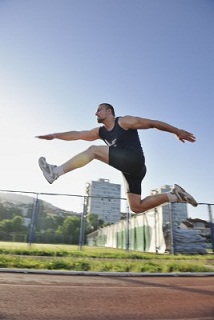Improving your running technique positively affects your speed and stamina over time. The only way for anyone to become a better, stronger runner is through practice.
It doesn’t matter whether you are training for a 5K run or are going through a very demanding marathon training schedule.
The more you practice the better you should become. However there is another key to this puzzle and it involves the techniques that you are using.
This is why it is critically important that you understand the correct techniques that are utilized by the elite runners around the world.
Is running on treadmill machines part of your training program? Your running technique is of crucial importance!

Elements For Correct Running Technique
The body mechanics you use when you are running are generally referred to as your ‘form’.
Casual runners sometimes believe that having ‘correct running form’ is unimportant. They rationalize that only a serious runner should have to worry about learning the right body motions.
However the truth is that it is very important for even novice runners to understand and use correct running form.
Incorrect running form is going to prevent you from developing to your full potential.
Better techniques are going to help prevent injuries. You will be able to improve your speed, strength and stamina with the least amount of expended effort. This will result in less frustration because of your rapid development.
Let’s look into the most important elements of a good running form.
1. Proper Posture
Those top runners seem to be moving without any strain or effort. Their posture is balanced which is what yours should be as well. Learn where your center of gravity is and then practice until you have learned to develop the perfect posture balance. This should be a comfortable, natural position that is relaxed with a very slight, forward tilt.
The key is to keep your upper body balanced in relation to your hips. Keep your shoulders pulled back, hips pushed forward and your chest out for maximum motion efficiency.
As you practice keeping your hips pressed forward you will find that you are able to lift your knees higher. This knee motion will be faster and more effortless than the same moves you have practiced in the past. Forward hips will also help you prevent the common fault of letting those feet lead your body.
2. Relaxation
A confident and serious runner will learn to relax their muscles before, during and after a run. Too much tension can decrease your speed and increase your chance of an injury.
3. Efficient Stride Length
In my opinion an incorrect stride is one of the most problematic flaws in running form. Most people try to increase their stride in the belief it will help them run faster but this is not what happens. You do need to concentrate on maximizing your stride but not to the point of overextension.
If your running technique has a precise and accurate stride you will be able to land with your foot directly under your body’s center of gravity when the stride cycle is completed. Learning to open your natural stride and letting your body momentum keep time with your forward ‘foot plant’ is crucial.
4. Good Body Mechanics
Always direct your body forward and try to keep from weaving, twisting or bobbing. These are small flaws in running form that stress your joints, cost you time, and waste your energy reserves. Pretend you are practicing that perfect posture of a model and trying to keep a book balanced on your head.
Light, quick steps that do not make much noise are essential. Landing with lots of weight and noise signal poor running technique.
5. Correct Knee Lift
Lifting your knees too high in an over-exaggerated manner is not proper running technique. You should only use a high knee lift when you race for that final finish line or if you are a competitive sprinter.
Learn to pull back just a little with your leading foot back and let it match your body speed, not race ahead of your body. Keeping your legs moving rhythmically with forward knee motions can help you glide around the track with speed, efficiency and a winning running form.
6. Proper Arm Motion
Your arms need to be relaxed and loose and kept close toward your sides. Allow them to swing back and forth rhythmically but do not tense your hands and wrists.
For proper running technique the arms should form a 90 degree angle with the elbows bent and you should drive the elbows toward the back of your body not toward the front.

Running Technique Drills
Practicing running technique is the foundation that no runner can afford to overlook. This means building a solid base with running drills.
The results will be a strong body, good conditioning and the best running form you can possibly muster.
Do not neglect the need to practice base running as part of your drills. This is a slow and relaxed pace that will allow you to talk with a partner and not become out of breath.
You will incorporate a running schedule that includes long slow runs, easy relaxed runs, steady state running and recovery running.
Understanding Pose Running Techniques
Pose running techniques focus on creating forward motion with the least energy and effort but gaining the maximum efficiency and power. It is based on body alignment and a sequence of simple body movements. With Pose Running form techniques you are incorporating gravity as the power for your forward motion as opposed to the expenditure of your own bodily energy sources.
Once you learn to keep your knees comfortably bent and master the ‘S’ body silhouette you will discover that Pose Running is your new best friend. In addition to reducing stress and strain on your body these techniques will help you reach faster speeds and better racing performances.
Return from Running Technique to Running Tips
Return to Marathon Training Tips home
